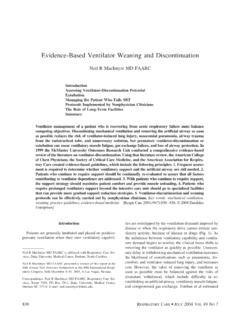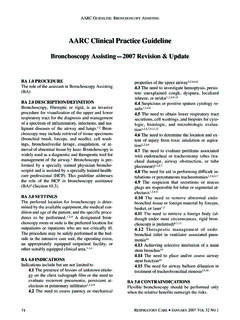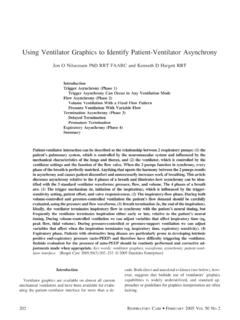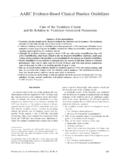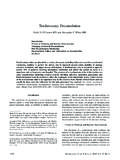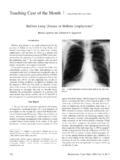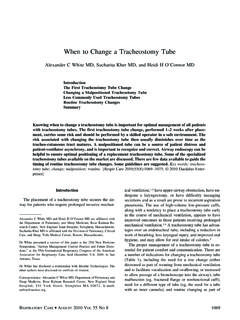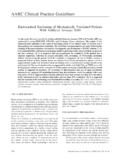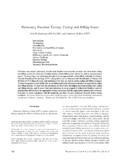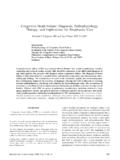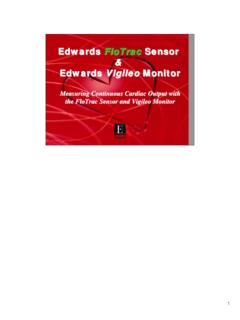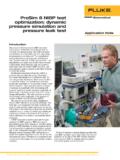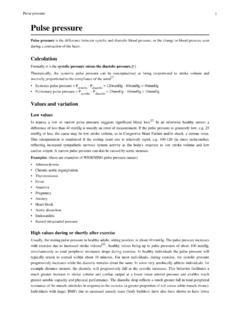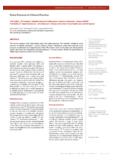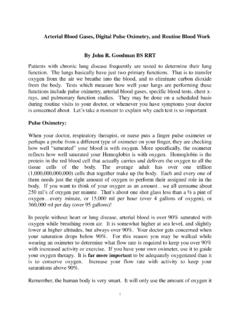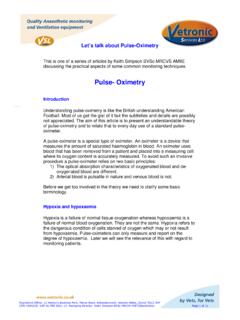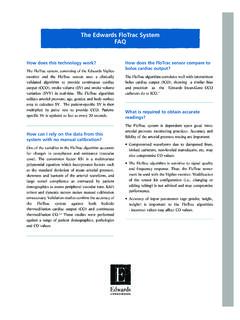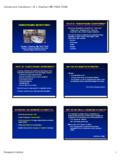Transcription of RESPIRATORY CARE Standard Abbreviations and …
1 637 RESPIRATORYCARE JUNE 97 VOL42 NO6 Primary SymbolsPrimary symbols are denoted by upper case, or capital ComplianceS Saturation in the bloodD Diffusing capacityphaseF Fractional concentrationt Timeof a gasT TemperatureP PressureV Gas volumeqBlood flowX Any variableQ Blood volumeX Mean valueA bar over a primary symbol denotes a mean or averaged value;for example, xis a mean pressure. A dot over a primary sym-bol denotes a time derivative, for example, yis dV/dt, or second derivative, with respect to time, is denoted by twodots above the primary symbol, for example, V is d2V/dt2, SymbolsQualifying symbols may be denoted by characters of regu-lar size following the primary symbol or by subscripted char-acters depending on printing AlveolarI InspiredB BarometricL LungD Dead space; wasted ventilationT TidalE ExpiredATPD Ambient temperature and pressure, dryATPSA mbient temperature and pressure, saturatedwith water vapor at these conditionsBTPSBody temperature and pressure, saturated withwater vapor at these conditionsSTPDS tandard conditions: temperature 0 dC (273 dK),pressure 760 torr and dryaArterialestEstimatedan Anatomicmax MaximalbBlood, in generalrbRebreathingcCapillaryvVenous cPulmonary end-capillaryfMixed venousAbbreviations & Symbols in Common UseLung VolumesTLCT otal lung capacity: the volume in the lungs atmaximal inflationRVResidual volume: the volume of air remainingin the lungs after a maximal exhalationERVE xpiratory reserve volume: the maximalvolume of air that can be exhaled from theend-expiratory positionIRVI nspiratory reserve volume.
2 The maximal vol-ume that can be inhaled from the end-inspira-tory levelICInspiratory capacity: the sum of IRV and TVIVCI nspiratory vital capacity: the maximumvolume of air inhaled from the point of maxi-mum expirationVCVital capacity: the volume equal to TLC RVVTT idal volume: that volume of air moved intoor out of the lungs during quiet breathing(VT indicates a subdivision of the lung;when tidal volume is precisely measured, asin gas exchange calculation, the symbol VTor VTis used.)FRCF unctional residual capacity: the volume inthe lungs at the end-expiratory positionRV/TLC% Residual volume expressed as percent of TLCVAA lveolar gas volumeVLActual volume of the lung including thevolume of the conducting airwaysForced SpirometryFVCF orced vital capacity: the determination of thevital capacity from a maximally forced expira-tory effortFEVtForced expiratory volume (time): a genericterm indicating the volume of air exhaledunder forced conditions in the first tsecondsFEV1 Volume that has been exhaled at the end ofthe first second of forced expirationRESPIRATORYCARES tandard Abbreviations and SymbolsEditor s Note: This compilation is adapted from the recommendations of the American Physiological Society and theACCP-ATS Committee on Pulmonary Nomenclature.
3 Some additions have been expiratory flow related to someportion of the FVC curve; modifiers refer toamount of FVC already exhaledFEFmaxThe maximum instantaneous flow achievedduring a FVC maneuverFEF25-75%Forced expiratory flow over the middle half ofthe FVC, that is, the average flow from thepoint where 25% of the FVC has been exhaledto the point where 75% has been exhaled. Thisformerly has been called the maximal midex-piratory flow rate (MMEFR).FIFF orced inspiratory flow: (Specific measure-ment of the forced inspiratory curve isdenoted by nomenclature analogous to that forthe forced expiratory curve. For example,maximum inspiratory flow is denoted otherwise specified, volume qualifiersindicate the volume inspired from RV at thepoint of measurement.)PEFThe highest forced expiratory flow measuredwith a peak flow meterMVVM aximal voluntary ventilation: volume of airexpired in a specified period during repetitivemaximal effortVentilationfBreathing frequency (breaths/minute orbreaths/min)yAAlveolar ventilation/minyDPhysiologic dead space ventilation/minyEExpired volume/min.
4 VEis exhaled volume/breathyCO2 Carbon dioxide production/min corrected forSTPD conditionsyO2 Oxygen consumption/min corrected for STPD conditionsPulmonary MechanicsCdynDynamic compliance: compliance measuredat point of zero gas flow at the mouth duringactive breathingCstStatic compliance: compliance measuredunder conditions of prolonged interruption ofairflowEElastance: the reciprocal of complianceGawAirway conductance: the reciprocal of RawsGawAirway conductance at a specific lung volumePawPressure in the airway; further modifiers to bespecifiedPAAlveolar pressurePesEsophageal pressure used to estimate PplPLTranspulmonary pressurePplIntrapleural pressurePtmTransmural pressure, pertaining to an airwayor blood vesselPImaxMaximal inspiratory pressure; this term isoften symbolized as MIPPEmaxMaximal expiratory pressure; this term isoften symbolized as MEPRR esistance (ie, pressure per unit flow)R Mean total resistance ([RI+RE] 2)RawAirway resistanceRETotal expiratory resistance measured byesophageal balloon methodRITotal inspiratory resistance measured byesophageal balloon methodRLLung resistanceWOBWork of breathingBlood Gas, Acid-Base, &Gas Exchange TermsPaO2 Arterial oxygen tension, or partial pressurePAO2 Alveolar oxygen tension, or partial pressurePaCO2 Arterial carbon dioxide tension, or partialpressurePACO2 Alveolar carbon dioxide tension, or partialpressurePfO2 Oxygen tension of mixed venous bloodP(A-a)O2 Alveolar-arterial oxygen tension term formerly used (A-aDO2) is (a/A)O2 Alveolar-arterial tension ratio.
5 PaO2: propose the term oxygen exchange indexto describe this (a-v)O2 Arteriovenous oxygen content differenceSaO2 Oxygen saturation of the hemoglobin ofarterial bloodSpO2 Oxygen saturation as measured by pulseoximetryCaO2 Oxygen content of arterial bloodpHSymbol relating the hydrogen ion concentra-tion or activity of a solution to that of a stan-dard solution; approximately equal to thenegative logarithm of the hydrogen ion con-centration. pH is an indicator of the relativeacidity or alkalinity of a Flow and ShuntsQBlood volumeqBlood flow (volume units and time must bespecific)SI UNITS, Abbreviations , & SYMBOLS638 RESPIRATORYCARE JUNE 97 VOL42 NO6 QcPulmonary capillary blood volumeQspPhysiologic shunt flow (total venousadmixture)qsp/qtotShunt as percent of total blood flowDiffusing CapacityDLCOsbDiffusing capacity of the lung for carbonmonoxide determined by the single-breathtechniqueDmDiffusing capacity of the alveolocapillarymembrane (STPD)D/VADiffusion per unit of alveolar volume, with Dat STPD and VA in liters BTPSSI Units with AbbreviationsSI units are decimal units of measurement for physical prop-erties and quantities that have been adopted by the scientificcommunity worldwide.
6 The reader is referred to RespirCare 1988;33:861-873, Respir care 1989;34:145, andRespir care 1997;42(6):639-640 for more , or energyjouleJSI UNITS, Abbreviations , & SYMBOLS639 RESPIRATORYCARE JUNE 97 VOL42 NO6 Syst me International:Examples of Conversions Commonly Used in RESPIRATORY Physiology and RESPIRATORY CarePhysicalKnownDesiredQuantityUnitUnit Example of Conversion CalculationForce (or mass)lbkg150 lb M=68 kgkglb68 kg M=150 lbPressuretorrkPa35 torr M= kPa M=35 psi MM=52 torr MM= psiWorkL tcm H2 Okg tm20 L tcm H2O MM= Kg tmJL tcm H2O2 J MM=20 L tcm H2 OPowerkg tm tmin kg tm tmin 1M= WCompliancemL/cm H2OL/kPa100 mL tcm H2O MM= L tkPa 1 Resistancecm H2O ts tL 1kPa ts tL 155 cm H2O ts tL 1M= kPa ts tL 1 Note: Retain all digits during computation to avoid roundoff error. However, the least precise measurement used in a calculation determines the number of significant digitsin the answer.
7 Thus, the final product or quotient should be written with the same number of significant figures as the term with the fewest significant figures, as shown in theexamples above. The least ambiguous method of indicating the number of significant figures is to write the number in scientific notation. For example, the number 30 mayhave either one or two significant figures, but written as M101, it is understood that there are two significant figures. For more information about scientific notation,significant figures, and rounding off, see Lough MD, Chatburn RL, Shrock WA, Handbook of RESPIRATORY care . Chicago: Yearbook Medical Publishers, 1985 kPa1 torr1 cm H2O1 torr1 cm H2O1 cm torr1 cm J1 L tcm H2O1 kg J1 kg J1 L tcm kg W1 kg tm tmin kPa tL 11 cm H2O ts tL 11L1000 L tkPa 11 L tcm H2O kg1 lbSI UNITS, Abbreviations , & SYMBOLS640 RESPIRATORYCARE JUNE 97 VOL42 NO6 Syst me International:Conversion Factors for Units Commonly Used in MedicinePhysical QuantityConventional UnitSI UnitConversion Factor*Lengthinch (in.)
8 Meter (m) 4foot (ft) M10 90 VolumedL (=100 mL) of substancemg/dLmmol/L10/molecular weightmEq/Lmmol/LvalencemL of gas at 62 Force (weight)pound (lb)newton (N) H2 Okilopascal (kPa) 06mm Hg (torr) 3 (psi) (mbar) 0 Work, energykg tmjoule (J) tcm H2 Ojoule (J) 06calorie (cal)joule (J) (kcal)J4 185 British thermal unit (BTU) 1055 Powerkg tm tmin 1watt (W) 4 Surface tensiondyn/ H2 H2O ts tL 1kPa ts tL 06cm H2O tmin tL 1kPa ts tL transport (ideal gas, STPD)mL ts 1t cm H2O 1mmol ts 1tkPa 0 TemperaturedCdKdK =dC + =(dF 32) =( tdC) + 32*To convert from conventional to SI unit, multiply conventional unit by conversion factor. To convert in the opposite direction, divide by conversion factor. Examples:10 torr =10 , 3 kPa = kPa, 1 L =1 =10 dLa-Aarterial-alveolarAARCA merican Association for RESPIRATORY CareABGarterial blood gasACCPA merican College of Chest PhysiciansAHAA merican Hospital AssociationAIartificial intelligenceAIDS acquired immunodeficiency syndromeALSamyotrophic lateral sclerosisAMPadenosine monophosphateAPRV airway pressure release ventilationARDS acute RESPIRATORY distress syndromeARFacute RESPIRATORY failureATSA merican Thoracic Societyauto-PEEP unintended positive end-expiratory pressureB-Pbronchopleural (eg, B-P fistula or air leak)
9 BPDbronchopulmonary dysplasiaCAIcomputer-assisted instructionCCCchondroplasia calcificans congenitaCDCC enters for Disease ControlCINAHLC umulative Index to Nursing & Allied HealthLiteratureCLDchronic lung diseaseCOcarbon monoxideCOLD chronic obstructive lung diseaseCOPcolloid oncotic pressureCOPD chronic obstructive pulmonary diseaseCO2carbon dioxideCPAP continuous positive airway pressureCPRcardiopulmonary resuscitationCPTchest physical therapyCTcomputerized tomographyDLCO sbsingle-breath diffusion of carbon monoxideacross the lungDMEdurable medical equipmentDRGdiagnosis-related groupECMO extracorporeal membrane oxygenationEIBexercise-induced bronchospasmEOAesophageal obturator airwayEPAPend-positive airway Food & Drug AdministrationFEF25-75%forced expiratory flow over middle half ofFVCFEV forced expiratory volumeFEV1forced expiratory volume in first secondFIO2fraction of inspired oxygenFDO2fraction of oxygen delivered (by device)FRCfunctional residual capacityFVCforced vital capacityHCFAH ealth care Financing AdministrationHFVhigh-frequency ventilationHFJV high-frequency jet ventilationHFOhigh-frequency oscillationHFOV high-frequency oscillatory ventilationHFPPV high-frequency positive-pressure ventilationHFPV high-frequency percussive ventilationHIVhuman immunodeficiency virusHMDhyaline membrane diseaseHMEheat & moisture exchanger (artificial nose)HMEF heat & moisture exchanging filterICPintracranial pressureICUintensive care unitI-Einspiration-expiration (ratio)
10 ILDinterstitial lung diseaseIMVintermittent mandatory ventilationIPPB intermittent positive-pressure breathingMIGET multiple inert gas elimination techniqueMIPmaximal inspiratory pressureMLTminimal leak technique (of cuff inflation)MRImagnetic resonance imagingMVmechanical ventilationNBRCN ational Board for RESPIRATORY CareNFPAN ational Fire Protection AssociationNGnasogastric (tube)NHLBIN ational Heart, Lung, & Blood InstituteNIHN ational Institutes of HealthNOTTN octurnal Oxygen Therapy TrialNO2nitrous oxideNPPV noninvasive positive pressure ventilationOSAobstructive sleep apneaO2oxygenP(A-a)O2alveolar-arterial oxygen-tension differencePaCO2arterial carbon dioxide tensionPaO2arterial oxygen tensionPCPP neumocystis cariniipneumoniaPDApatent ductus arteriosusPEEP positive end-expiratory pressurePFCpersistent fetal circulationPFTpulmonary function test or testingPIEpulmonary interstitial emphysemaPO2oxygen tensionPSVpressure-support ventilationPfO2mixed venous oxygen tensionSI UNITS, ABBRE
